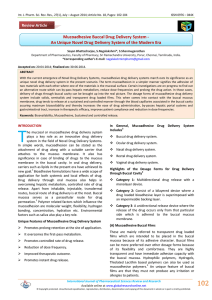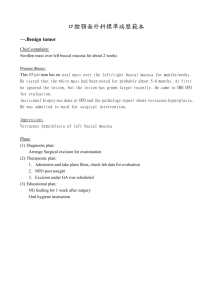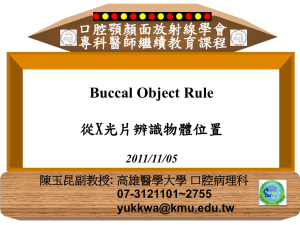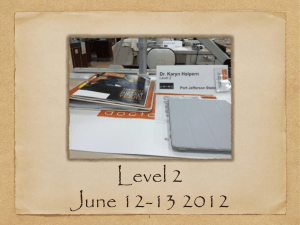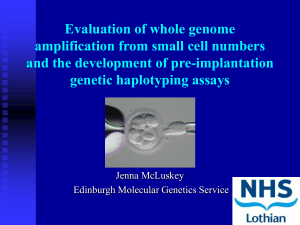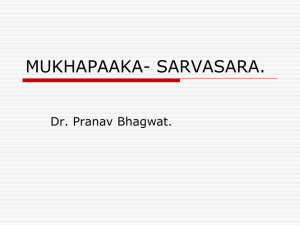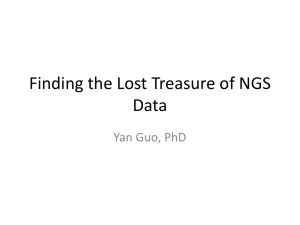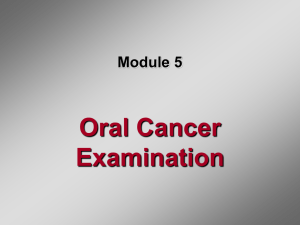Design And Evaluation Of Mucoadhesive Bilayered Devices For
advertisement
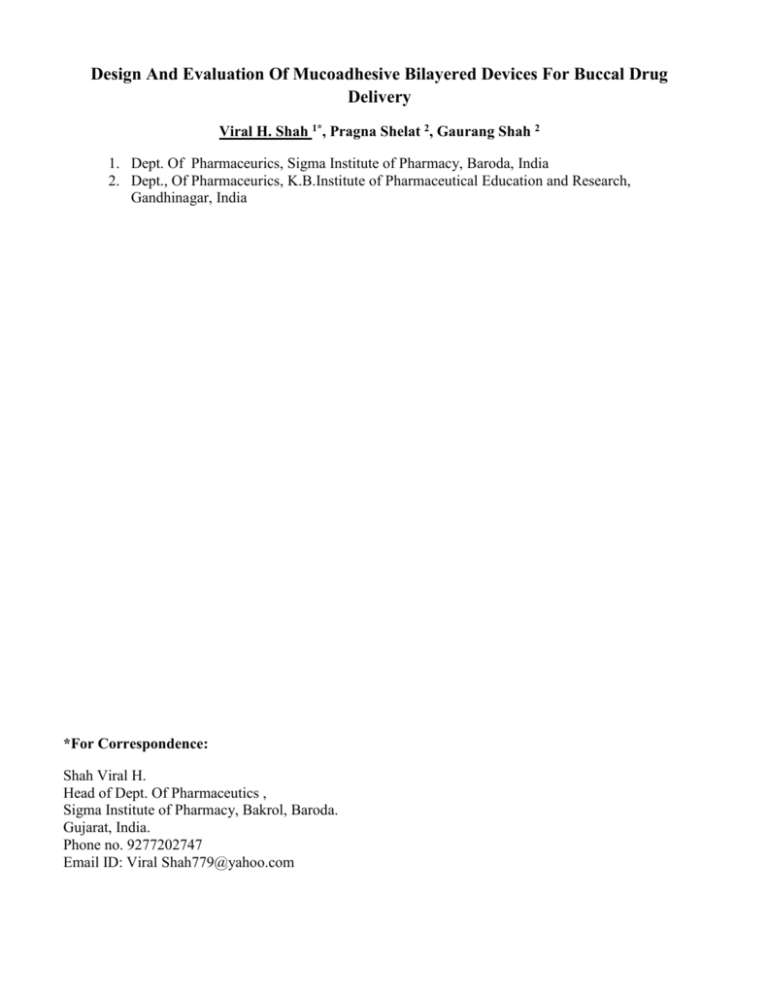
Design And Evaluation Of Mucoadhesive Bilayered Devices For Buccal Drug Delivery Viral H. Shah 1*, Pragna Shelat 2, Gaurang Shah 2 1. Dept. Of Pharmaceurics, Sigma Institute of Pharmacy, Baroda, India 2. Dept., Of Pharmaceurics, K.B.Institute of Pharmaceutical Education and Research, Gandhinagar, India *For Correspondence: Shah Viral H. Head of Dept. Of Pharmaceutics , Sigma Institute of Pharmacy, Bakrol, Baroda. Gujarat, India. Phone no. 9277202747 Email ID: Viral Shah779@yahoo.com ABSTRACT The objective of this study was to develop an effective pravastatin buccal adhesive tablet with excellent bioadhesive force and good drug stability in human saliva. The study also focuses on the mucoadhesive potential of some natural gums like tamrind gum , xanthan gum and gellan gum. Bilayered Buccoadhesive compacts with one layer of drug and mucoadhesive polymer and second non medicated, non permeable layer of ethylcellulose and Mg stearate was prepared using direct compression technique. Physicochemical properties of tablets like bioadhesive strength, swelling rate, surface pH, permeation rate and in vitro drug release rate were studied. As bioadhesive additives for tablets , a mixture of polymers like some natural gums along with chitosan was selected. Release studies revealed that the sustained release of pravastatin over several hours may be obtained by combining the chitosan with natural gums. Also the bioavailability studies indicated that bioavailability of pravastatin was enhanced using the above mentioned drug delivery system. Thus the potential of above mentioned drug delivery device is promising and may be considered as a novel tool inorder to improve the therapeutic efficacy of various drugs with shorter half life and poor bioavailability. KEYWORDS Mucoadhesion, Buccal drug delivery, Bilayered compact, Pravastatin, Natural gums. INTRODUCTION The oral cavity is being increasingly used for the administration of the drugs, which are mainly designed for the delivery of contained medicaments through the oral mucosa into the systemic circulation. Buccal mucosa consisting of stratified squamous epithelium supported by a connective tissue lamina propia was investigated as a site for drug delivery several decades ago and the interest in this area for the transmucosal drug administration is still growing. Buccal mucosa makes a more appropriate choice of site if prolonged drug delivery is desired because buccal site is less permeable than the sublingual site. Delivery of drugs through buccal mucosa overcomes premature drug degradation due to harsh environmental conditions within the GI tract, as well as active drug loss due to first pass metabolism and inconvenience of parenteral administration is also avoided. In addition there is excellent acceptability and drug can be applied, localized and may be removed easily at any time during the treatment period. However the conventional buccal dosage forms show limitations due to involuntary swallowing of the dosage form itself or a part of it may get dissolved and diluted by the salivary flow and will not be available for transmucosal absorption1. From technological point of view an ideal buccal dosage form must have three properties: i) it must maintain its position in mouth for a few hours. ii) It should release the drug in an controlled manner. I iii) It should provide the release in an unidirectional way towards the mucosa.2 All the above mentioned properties can be achieved by developing a buccal mucoadhesive system with a non permeable backing layer. Bioadhesion, in particular mucoadhesion, has been area of interest for the development of controlled drug delivery systems to improve buccal, nasal and oral administration of drugs. Mucoadhesion can be explained by two major phenomenon.3 The first is the formation of electrostatic, hydrophobic or hydrogen bonds at the interface between the polymer and mucin. The second is the diffusion of polymer chains in the mucus layer.4 Hyperlipidemia is a major cause of atherosclerosis and its associated disorders like coronary heart diseases, ischemic cerebrovascular diseases etc.Recognition of hypercholestermia as a risk factor has led to the development of drugs that reduces cholesterol levels. Statins are the most effective antihyperlipidemic agents. Statins act as a competitive inhibitors of HMG-CoA reductase which catalyzes the step of cholesterol synthesis. Statins also reduces the triglycerides levels caused by elevated VLDL levels. All the statins are subjected to extensive first past metabolism by liver and gut wall enzymes, resulting in low systemic availability of the parent compound. Pravastatin is administered in its active β- hydroxy acid form as a sodium salt and most of the adsorbed drug undergoes extensive first pass metabolism and the metabolites so produced possess a little HMG-CoA reductase inhibitory activity The main objective of the study was to enhance the bioavailability of pravastatin by developing a bilayered buccal mucoadhesive compact of the drug using different natural mucoadhesive polymers. MATERIALS ANS METHODS MATERIALS Chitosan (molecular mass: 400 kDa, 85% deacylated) was obtained from Central Fisheries Cochin, India. Xanthan Gum, Gellan Gum and Tamrind Gum were purchased form Loba Chem. Mumbai, India. All the other compounds, reagents polymers and solvents were purchased from Sigma Aldrich, Mumbai, India. METHODS Standardization of Gums Standardization of natural gums was done based on following evaluation parameters like loss on drying, total ash value, viscosity of 1 % solution, particle size, pH of 1 % solution and microbial load. In vitro mucoadhesive strength determination of polymers. 5,6 Rotating cylinder method In this method 50 mg of the polymer was compressed in to 5.0 mm diameter disc, then these discs so prepared were adhered to the freshly excised gastric mucosa of male Albino rats by just hydrating the discs with little amount of water and placing them on stomach mucosa by applying little pressure. The whole system was pasted on the stainless steel cylinder of USP XXVI apparatus ( type 4) with the aid of the cyanoacrylate glue and the cylinder was immersed in the dissolution jar filled with phosphate buffer pH 7.2 at 37ºC and was agitated at 125 rpm as shown in Fig.1 and the time for the detachment, disintegration or erosion of the test discs was monitored and reported in table 1.. Interaction Studies Drug Polymer Interaction studies were performed using FTIR spectroscopy. Preparation of bilayered mucoadhesive buccal compacts. 7,8,9,10,11 Bilayered compacts were prepared by a direct compression procedure involving two consecutive steps. The non medicated layer was first compressed then the medicated layer was filled into the die cavity and both layers were compressed together. In the first step the backing membrane was created by blending the ethyl cellulose and Mg stearate mixture and the blended powder of backing layer was then compressed using flat faced punch, 9 mm in diameter. In the second step the mucoadhesive polymer/drug mixture was prepared by homogeneous mixing in mortar pestle for 15 mins. The mixture was then filled in the die cavity and was compressed on previously obtained backing layer. Various formulations consisting of different polymers in varied composition were prepared as shown in the table 2. Evaluation of bilayered mucoadhesive buccal compacts. 12,13 Bilayered compacts so prepared were evaluated for following preliminary evaluation tests like hardness, weight variation, friability, thickness, mucoadhesive strength, permeation studies and In vitro release studies. Three individual compacts from each batch were used and the results were averaged. Hardness was determined using a Monsanto type of hardness tester. Weight variation was determined as per USP were the tolerance limit was 7.5%. Friability was determined using a Roche type of friabilator. Thickness of buccal compact was determined using digital vernier caliper as indicated in table 3. In vitro release studies 14 The in vitro drug release studies of buccal compacts were carried out using USP dissolution apparatus 1. In order to mimic the in vivo adhesion of the devices, the buccal compact was attached through cyanoacrylate glue to the bottom end of the stirring rod instead of basket fixtures. By this only peripheral layer of the buccal compact was exposed to the dissolution medium. The rotation speed was kept to be 50 rpm and 500 ml phosphate buffer pH 6.6 was used as the dissolution medium maintained at 37+0.5°C. Aliquots were withdrawn at different time intervals and analyzed spectrophotometrically at 238nm. The dissolution studies were conducted in triplicates and the mean values were plotted verses time with standard error, indicating the reproducibility of results as indicated in fig. 2. In vitro Drug Permeation Studies 15,16,17 From the local slaughter house porcine buccal mucosa was collected and was immediately transported to the laboratory in cold normal saline solution. The buccal mucosa, with a part of sub mucosa was carefully separated from fat and muscles using scalpel. The buccal epithelium was used within two hours after removal. The in vitro buccal drug permeation study was performed using a Franz diffusion cell at 37°C ± 0.2°C. Buccal mucosa was mounted between the donor and receptor compartments. The receptor compartment(20-ml capacity) was filled with phosphate buffer pH 6.6. The buccal mucosa was allowed to stabilize for a period of one hour. The buccal compact was placed with the core facing the mucosa, and the compartments were clamped together. The hydrodynamics in the compartment was maintained by stirring with a magnetic bead at uniform slow speed. Samples were withdrawn at predetermined time intervals and analyzed for drug content by UVspectrophotometer. Swelling Study 18,19 Buccal compacts were weighed individually (W1) and placed separately in 2% agar gel plates with the core facing the gel surface and incubated at 37°C ± 1°C. After 6 hours, the compact was removed from the Petri dish and excess surface water was removed carefully using filter paper. The swollen compact was then reweighed (W2), and the swelling index (SI) was calculated using the following formula and results were reported in table 4. SI = (W2 - W1) X 100 W1 Surface pH Study18,19 The surface pH of the buccal compacts was determined in order to investigate the possibility of any side effects in vivo. As an acidic or alkaline pH may irritate the buccal mucosa, so the surface pH should be as close to neutral as possible. The method adopted by Bottenberg et. al. was used to determine the surface pH of the compact. A combined glass electrode was used for this purpose. The compact was allowed to swell by keeping it in contact with 1 mL of distilled water for 2 hours at room temperature. The pH was identified by bringing the electrode into contact with the compact surface and allowing the surface to equilibrate for 1 minute. The results were reported in table 4. In vitro mucoadhesive strength dtermination 20,21 In vitro mucoadhesive strength of the optimized formulation was determined using time based and forced based technique and the results were reported in table 5. Force based technique 22 Tensile experiments were done on Instron app. (Model 4301), using porcine buccal mucosa. Cynoacrylate glue was used to fix the compact and the porcine mucosa to the upper and lower metalic supports respectively. 20µl of distilled water was dropped on the compact surface and the compact and the mucosa was brought in contact with a force of 0.5N and kept in this condition for 10 mins. Then the tensile experiment was performed at a constant extension rate of 5mm/min. Time based Technique It was performed using rotating cylinder method as mentioned above. Bioavailability Assessment of Pravastatin The potential of the mucoadhesive buccal tablets to deliver pravastatin to the systemic circulation in a sustained fashion was evaluated by conducting the bioavailability experiments. Two groups of rabbits were taken, each group consisting of three rabbits in the weight range of 2.5-3kgs. Animals were anesthetized by an i.m injection of 1:5 mixture of Xylazine (1.9mg/kg) and ketamine (9.3 mg/kg). The rabbits were fasted for 12 h before until the end of the experiment.To one group of rabbits marketed Pravastatin tablets PRAVATOR® were given and to the other group buccal adhesive tablets were placed on the upper gingiva. From both the groups 2-ml blood samples were collected before the administration of the tablets and at time intervals of 1, 2, 4, 6, 8, and 12h respectively. The catheter was placed in the marginal ear vein for blood collection when the rabbits were anesthetized. After the collection of the blood sample every time the cannula was flushed with 0.2ml of a 10% (v/v) heparin solution to keep the cannula open.All the blood samples were centrifuged at 3000 rpm for 10 mins to separate plasma. The retrived plasma was stored at -20°C until the time of analysis. Quantitation of Plasma Pravastatin. Pravastatin was quantified using a Shimadzu high performance liquid chromatography (HPLC) system consisting of an ultraviolet detector. The Class LC10 software version 1.6(Shimadzu) was used for data analysis and processing. The compounds were separated at 50 °C on a C18 column (5m, 250×4.6mm I.D.) with guard column and quantified by ultraviolet detection at 239 nm. For preparation of the mobile phase, 300 ml of acetonitrile was mixed with 700 ml of 0.05M potassium dihydrogen phosphate puffer, adjusted to a pH of 2.3 with concentrated phosphoric acid. The mobile phase was delivered at a flow rate of 1.0 ml/min. The substances were quantified using their peak area ratio to the internal standard. In a 2 ml polypropylene tube, 1.0 ml plasma was mixed with 50 l internal standard solution (1g clonazepam/1 ml methanol) and 1ml of methanol. The proteins were precipitated under agitation for 20 min at room temperature. Samples were spun for 10 min at 3000 rpm, supernatants were transferred into a 10ml glass tube and diluted with 2.5 ml of distilled water. After conditioning with 2ml of methanol/acetonitrile (1:1, v/v) and 2ml of distilled water the extracts were introduced onto the columns. After washing with water, with 5% methanol in water and with n-hexane, the samples were eluted with 2ml of methanol/acetonitrile (1:1, v/v). After evaporation to dryness at 40°C under a stream of nitrogen, the dried extracts were resolved in 100 l of 30% acetonitrile in water. The complete reconstituted extract was subjected to HPLC analysis. Preparation of stock solutions and calibration standards : A stock solution was prepared by dissolving 40 mg Pravastatin in 80 methanolic solution in a 50ml volumetric flask. The working solution was obtained by dilution with methanol to a final concentration of 80 g/ml. This solution was used for preparation of calibration standards and quality control samples. For the preparation of the internal standard solution, 10.0 mg clonazepam were dissolved in methanol in a 10ml volumetric flask. The working solution was obtained by dilution with methanol to a final concentration of 1g/ml. For calibration standards, 20 µl working solution was evaporated to dryness and reconstituted in 20 ml blank human plasma yielding the highest calibration standard with a concentration of 240 ng/ml Pravastatin, which was then used to generate standard samples with final Pravastatin concentrations of 1.9, 3.8, 7.5, 15.0, 30.0, 60.0, and 120.0 ng/ml by serial dilution with blank plasma. Calibration standards, and blank plasma samples were stored at −20 °C until analysis. Stability studies Stability studies were carried out for optimized formulations as per ICH guidelines by placing the formulations at 40°C / 75% RH for 90 days in stability chamber. The formulation was then characterized for its various physical and pharmaceutical parameters after stability studies. ESTIMATION OF PHARMACEUTICAL CHARACTERISTICS AFTER STABILITY STUDIES as shown in Table 8 and 9 and fig, 8 and 9. RESULTS AND DISCUSSIONS In vitro mucoadhesive strength determination of polymers (Rotating cylinder method) t The in vitro mucoadhesive test results as mentioned in Table1. showed that Chitosan disc erroded quickly allthough it was not detached from the mucosa. Natural gums like xanthan gum, gellan gum and tamrind gum showed good mucoadhesive strength. Evaluation of bilayered mucoadhesive buccal compacts. Interaction studies FTIR graphs revealed that there was no interaction between drug and polymer. In vitro drug release studies and In vitro drug permeation rate studies. The in vitro drug release and drug permeation studies results as indicated in fig. 2 and fig. 3 showed that use of plain chitosan as mucoadhesive polymer could not sustain the release of the drugs from the formulation.. Xanthan gum and tamrind gum showed sufficient sustaining properties but consecutive low permeation properties so the combination of chitosan and xanthan gum as well as tamrind gum resulted into a formulation which sustains the release of the drug from the formulation and also have high permeation rate Swelling properties, Surface pH and in vitro mucoadhesive strength determination studies. The swelling study results as indicated in table 4. Indicated that the optimized formulation has sufficient swelling character which is essential for good mucoadhesive properties as more will be the swelling , greater will be the exposure of the formulation to the biological surface and more will be the mucoadhesion. The surface pH of the optimized formulations was found to be in the range of buccal pH which indicated that there will be no irritation due to formulation on the buccal surface. Also the forced based and time based mucoadhesive strength dtermination studies as shown in Table 5. Indicated that optimized formulation showed good mucoadhesive strength. Bioavailability Assessment of Pravastatin. The Mean plasma conc. – time curve of Pravastatin from marketed formulation PRAVATOR ® and from buccal mucoadhesive bilayered compacts as shown in fig. 5 indicated that AUC of the mucoadhesive formulation was higher which indicated in enhanced bioavailability of pavastatin in mucoadhesive buccal compacts when compared to conventional pavastatin tablets. Stability studies The physical, chemical and pharmaceutical evaluation studies of the optimized formulation after stress conditions as indicated in table 8 and table 9 and fig.6 and fig. 7 revealed that the optimized formulation is sufficiently stable. REFERENCES: 1. Nina L, Jochen K, Andreas B, Development of buccal drug delivery systems based on a thiolated polymer: Int. J. of Pharm.2009;252: 141-148Andreas Bernkop-Schnurch, Davide Guggi, Yvonne Pinter, Thiolated Chitosans: development and in vitro evaluation of a mucoadhesive , permeation enhancing oral drug delivery system. Journal of Controlled Release. 2004;94: 177-186. 2. Chul Soon Yong, Jae-Hee Jung, Jong-Dal Rhee, Physiochemical Charecterization and Evaluation of Buccal Adhesive Tablets containing Omeprazole. Drug development and Industrial Pharmacy.2001; 27(5): 447-455. 3. El-Samaligy M S, Yahia S A, Basalious E B, Formulation and evaluation of diclofenac sodium Buccoadhesive discs. International Journal of Phharmaceutics.2004;286: 27-39. 4. Giuseppina Sandri, Silvia Rossi, Franca Ferrari, Maria Cristina Bonferoni. Assesment of Chitosan derivatives as buccal and vaginal penetration enhancers. European Journal of Pharmaceutical sciences.2004;21: 351-359. 5. Isabel Diaz del Consuelo, Francoise Falson, Richard H Guy. Ex Vivo evaluation of Bioadhesive films for buccal delivery of Fentanyl. Journal of Controlled Release.2007;122: 135-140. 6. Jafar Akbari, Ali Nokhodchi, Djavad Farid, Massoud Adrangui, Development and Evaluation of Buccoadhesive prpranolol hydrochloride tablet formulation: effect of fillers. IL Farmaco.2004; 59:155-161. 7. Llabot J M, Palma S D, Manzo R H, Allemandi D A, Design of Novel antifungal mucoadhesive films part II. Formulation and In vitro biopharmaceutical evaluation. International Journal of Pharmaceutics. 2007;336 : 263-268. 8. Luana Perioli, Valeria Ambrogi, Fausta Angelici, Maurizio Ricci. Development of mucoadhesive patches for buccal aministration of Ibuprofen. Journal of Controlled Release.2004;99:73-82. 9. Mia S, Tuononen T, Evaluation of microcrystalline chitosans for gastro-retentive drug delivery: Eur. J. Pharm. Biopharm.2003;19: 345-353. 10. Musnasur A P, Pillay V, Chetty D J, Govender T, Staistical optimization of mucoadhesivity and characterization of multipolymeric propranolol matrices for buccal therapy. International Journal of Pharmaceutics.2006;323:43-51. 11. Narendra C, Srinath M, Ganesh B, Optimization of Bilayer Floating Tablet Containing Metoprolol Tartrate as a Model Drug for Gastric Retention: AAPS Pharm Sci.Tech. 2006;7:45. 12. Narendra C, Srinath M S, Pralash Rao B, Development of three layered buccal compact contatining metoprolol tartarate by statistical optimization technique. International Journal of Pharmaceutics.2005;304: 102-114. 13. Nazila Salamat- Miller, Montakarn Chittchang, Thomas P. Johnston, The use of mucoadhesive polymers in buccal drug delivery, Advanced Drug Delivery Reviews. 2005;57: 1666-1691. 14. Andreas Bernkop-Schnurch, Davide Guggi, Yvonne Pinter, Thiolated Chitosans: development and in vitro evaluation of a mucoadhesive , permeation enhancing oral drug delivery system. Journal of Controlled Release. 2004;94: 177-186. 15. Noha Adel Nafee, Fatma Ahmed Isail, Nabila Ahmed Boraie, Mucoadhesive delivery systems. II formulations and In vitro/ Invivo Evaluation of Buccal Mucoadhesive Tablets Contatining water soluble drugs. Drug development and Industrial Pharmacy.2004;30(9): 995-1004. 16. Paolo Giunchedi, Claudia Juliano, Elisabetta Gavini, Massimo Cossu, Milena Sorrenti, Formulation and in vivo evaluation of chlorhexidine buccal tablets prepared using drug-loaded chitosan microspheres. European Journal of Pharmaceutics and Biopharmaceutics.2008;53: 233– 239. 17. Patel J K, Patel R P, Amin A F, Patel M M, Formulation and Evaluation of Mucoadhesive Glipizide Microspheres, AAPS Pharm.Sci.Tech.2005;6: 45-52. 18. Ramesha C, Madhusudan Y R, Vani G, In vitro and In vivo adhesion testing of mucoadhesive drug delivery system, Drug Development and Industrial Pharmacy. 1999; 25(5):685-690. 19. Shimona Geresh, Garik Y Gdalevsky, Igal Gilboa, Jody Voorspoels, Bioadhesive grafted starch polymers as platforms for peroral drug delivery: a study of Theophylline release. Journal of controlled Release.2004;94: 391-399. 20. Soliman Mohammadi-Samani, Rahim Bahri-Najafi, Golamhosein Yousefi, Formulation and invitro evaluation of Prednisolone muccoadhesive tablets, IL Farmaco. 2005; 60: 339-344. 21. Verma Navneet and Chattopadhyay Pronobesh, Preparation of mucoadhesive buccal patches of carvedilol and evaluation for in-vitro drug permeation through porcine buccal membrane. African Journal of Pharmacy and Pharmacology.2011;5(9):1228-1233. 22. Yajaman Sudhakar, Ketousetuo Kuotsu, Bandyopadhyay A K, Buccal bioadhesive drug delivery -A promising option for orally less efficient drugs. Journal of Controlled Release.2006; 114:15– 40. List of Tables: Table 1. In Vitro Mucoadhesive strength of Polymers POLYMER DISK DETACHMENT TIME (HOURS) IN PH 7.2 BUFFER + S.D. 2.35 + 0.52 Chitosan (disk disintegrates) Xanthan Gum 18.25 + 0.42 Tamrind Gum 15.15 + 0.25 Gellan Gum 18.30 + 0.50 Table 2. Composition of bilayered mucoadhesive buccal compacts. Components (mg) FORMULATIONS P1 Pravastatin P2 P3 P4 P5 P6 P7 P8 P9 P10 P11 P12 P13 P14 40 40 40 40 40 40 40 40 40 40 40 40 25 25 25 25 25 25 25 25 25 25 25 25 40 40 Magnesium Stearate 25 25 Ethyl Cellulose 25 25 25 25 25 25 25 25 25 25 25 25 25 25 5 5 5 5 5 5 5 5 5 5 5 5 5 5 Chitosan 50 100 --- --- --- --- --- --- --- --- --- 100 100 100 Tamrind Gum --- --- 50 100 150 --- --- --- --- --- --- 150 --- --- Xanthan Gum --- --- --- --- --- 50 100 150 --- --- --- --- 150 --- Gellan Gum --- --- --- --- --- --- --- --- 50 100 150 --- --- 150 Backing layer Aluminium Hydroxide (stabilizer) Table 3. Evaluation test results of bilayered mucoadhesive buccal compacts. Evaluation Test Results of various Formulations Tests Hardness P1 P2 P3 P4 P5 P6 P7 P8 P9 P10 P11 P12 P13 P14 4.4 4.6 4.4 4.2 4.8 4.5 4.6 4.8 4.4 4.6 4.6 4.4 4.4 4.6 Pass Pass Pass Pass Pass Pass Pass Pass Pass Pass Pass Pass Pass Pass Pass Pass Pass Pass Pass Pass Pass Pass Pass Pass Pass Pass Pass Pass 1.2 1.5 1.3 1.6 1.8 1.4 1.6 1.4 1.6 1.8 1.8 2.0 2.0 2.0 (Kg/cm2) Friability (%) Weight variation Thickness (mm) Table 4. Swelling Index and surface pH determination of bilayered mucoadhesive buccal compacts Formulation code P13 P14 Swelling Index 36 + 0.45 34 + 0. 52 Surface pH 6.7 + 0.5 6.6 + 0.4 Table 5. In vitro mucoadhesive strength determination of optimized formulations. Formulation code P13 P14 Detachment time (hours) 12 (disk remained undetached) 12(disk remained undetached) Detachment force(g/cm2 ) 96.7 + 0.5 95.7+ 0.5 Table 6. Calibration Standard for Plasma Pravastatin Estimation. SLOPE INTERCEPT r2 0.67 0.0045 0.9971 Table 7. Comparison of Pharmacokinetics of Fluvastatin after oral administration and buccal administration ORAL PHARMACOKINETIC ADMINISTRATION PARAMETER OF PRAVASTATIN BUCCAL ADMINSTRATION OF PRAVASTATIN C max (ng/ml) 54 52 t max (h) 2.2 4.5 AUC 0-12(ng/ml per h) 152 237 Table 8. Estimation of physical and chemical characteristics after stability studies Formulations Sampling Points Physical parameters Chemical parameters Colour Drug content 0th Month 3rd Month 6th Month 0th Month 3rd Month 6th Month No change No change No Change _ _ _ P13 No change No change No change 93.75 + 0.7% 95.43+ 0.5% 96.27+0.8% P14 No change No change No change 92.61 + 0.5% 90.76 + 0.5% 94.54 + 0.5% Bulk drug Table 9. Evaluation of pharmaceutical parameters after stability studies. Formulation code AVERAGE ADHESION FORCE (g/cm2) Swelling Index Surface pH P13 96.5+ 0.5 34 + 0.63 6.6 + 0.2 P14 94.8 + 0.5 32.5 + 0.52 6.5 + 0.5 List of Figures: Figure 1. Schematic presentation of the test system used to evaluate the mucoadhesive properties of tablets based on various polymers. c, cylinder; if, intestinal fluid; m, rat mucosa; t, tablet. % cumiliative release 100 80 60 P12 P13 P14 40 20 0 0 2 4 Time6in (h) 8 Figure 2. Dissolution profiles of bilayered mucoadhesive buccal compacts. 10 12 Figure 3. In vitro drug permeation profile of bilayered mucoadhesive buccal compacts Figure 4. HPLC trace of Pravastatin (PR) and the internal standard Clonazepam (IS) using ultraviolet detection at 239 nm .(A) Blank Plasma sample.). (c ) Plasma sample post 2 hours of administration of 40 mg pravastain adhesive tablets (B) Plasma sample post 2 hours of administration of 40 mg PRAVATOR® ng/ml Mean Plasma concentration - Time curve of Pravastatin 100 90 80 70 60 50 40 30 20 10 0 Marketed Pravastatin Tablets 0 1 2 3 4 5 6 7 8 9 1011121314151617181920 Time in hours % cumiliative release Figure 5. Mean plasma conc. –time curve of Pravastatin 100 90 80 70 60 50 40 30 20 10 0 P13 P14 0 1 2 3 4 5 6 7 8 Time in hours 9 10 11 12 Figure 6 In vitro release after stability studies % cumiliative release 120 100 80 P13 P14 60 40 20 0 0 1 2 3 4 5 6 7 8 Time in hours 9 10 11 12 Figure 7. In vitro Drug Permeation after stability studies.
